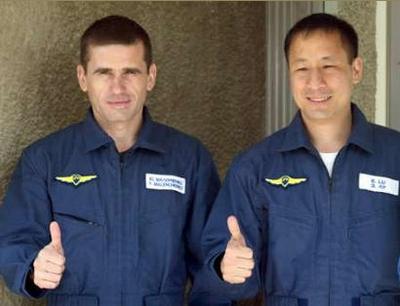Sun, Jul 13, 2003
NASA: ISS Team Doing Some Research, But Basically Keeping
House
 The International Space
Station’s Expedition 7 crewmembers concentrated on Station
upgrades and routine maintenance during their 11th week on orbit.
Commander Yuri Malenchenko and NASA ISS Science Officer Ed Lu also
advanced the research in several laboratory experiments during the
week and shared their experiences in both formal and informal
settings.
The International Space
Station’s Expedition 7 crewmembers concentrated on Station
upgrades and routine maintenance during their 11th week on orbit.
Commander Yuri Malenchenko and NASA ISS Science Officer Ed Lu also
advanced the research in several laboratory experiments during the
week and shared their experiences in both formal and informal
settings.
In the Russian segment of the Station, Malenchenko installed a
refurbished component of the Satellite Navigation System and new
pipe conduits in the condensate separation and pumping unit; all of
that hardware was delivered to the ISS last month on a Russian
resupply craft. The crewmembers upgraded a relay unit in the
Russian audio system which enables module-to-module
“telephone” calls; completed inspections of life
support systems, smoke detectors and microbe filters throughout the
Station; rebuilt and restored laptop computer hard disk drives; and
audited supplies to help mission managers decide what to launch on
upcoming Progress resupply ships.
So, How Ya Feelin'?
The presence of a crew on orbit supplies test subjects for human
life sciences research into how people respond to long periods in
the absence of gravity, and this week Malenchenko and Lu gathered
data for US and Russian experiments gauging their health in
microgravity. They also completed two hours or more of exercise
each day to maintain their muscle tone and cardiovascular
fitness.
Last weekend Lu set up an electronic still camera in the
Earth-facing window of the Destiny Laboratory for another session
of the EarthKAM experiment (Earth Knowledge Acquired by Middle
Schools). In this experiment, students in grades six through eight
study Earth geography and orbital mechanics to understand when
Station will be over a particular spot on Earth, and then submit
requests that are uplinked to the on-board computer that controls
the camera. The students later study the photos “they
took” of the Earth from an altitude of more than 240 miles;
more than 300 such photos were taken during this week’s
operations.

Hamming It Up
Malenchenko and Lu took time throughout the week to share the
experience of ISS. On Monday they used the Station’s amateur
radio system to answer questions from participants in the Euro
Space Center Space Camp in Belgium, and sent a message of greeting
and encouragement for a Space Day event at ceremonies commemorating
the 65th anniversary of the city of Korolev, home of the Russian
Mission Control Center. Tuesday they chatted with Japanese middle
school students at the "Tokyo FM" Radio Network station, and on
Thursday they discussed the mission with a reporter from the Voice
of America. Today they talked with the winners of a Russian school
science contest.
More News
“We respectfully call on the City of Mesa to: 1. Withdraw the landing fee proposal immediately 2. Engage with the aviation community before making decisions that impact safet>[...]
High Speed Taxiway A long radius taxiway designed and provided with lighting or marking to define the path of aircraft, traveling at high speed (up to 60 knots), from the runway ce>[...]
Aero Linx: International Federation of Airworthiness (IFA) IFA uniquely combines together all those with responsibility for policies, principles and practices concerned with the co>[...]
Controller’s Expectation That VW02 Would Have Departed Sooner Led To An Inadequate Scan And Loss Of Situational Awareness Analysis: A Robinson R-44 helicopter N744AF, VW02 (V>[...]
A Few Questions AND Answers To Help You Get MORE Out of ANN! 1) I forgot my password. How do I find it? 1) Easy... click here and give us your e-mail address--we'll send it to you >[...]
 Aero-News: Quote of the Day (12.09.25)
Aero-News: Quote of the Day (12.09.25) ANN's Daily Aero-Term (12.09.25): High Speed Taxiway
ANN's Daily Aero-Term (12.09.25): High Speed Taxiway ANN's Daily Aero-Linx (12.09.25)
ANN's Daily Aero-Linx (12.09.25) NTSB Final Report: Diamond Aircraft Ind Inc DA20C1 (A1); Robinson Helicopter R44
NTSB Final Report: Diamond Aircraft Ind Inc DA20C1 (A1); Robinson Helicopter R44 ANN FAQ: Q&A 101
ANN FAQ: Q&A 101




